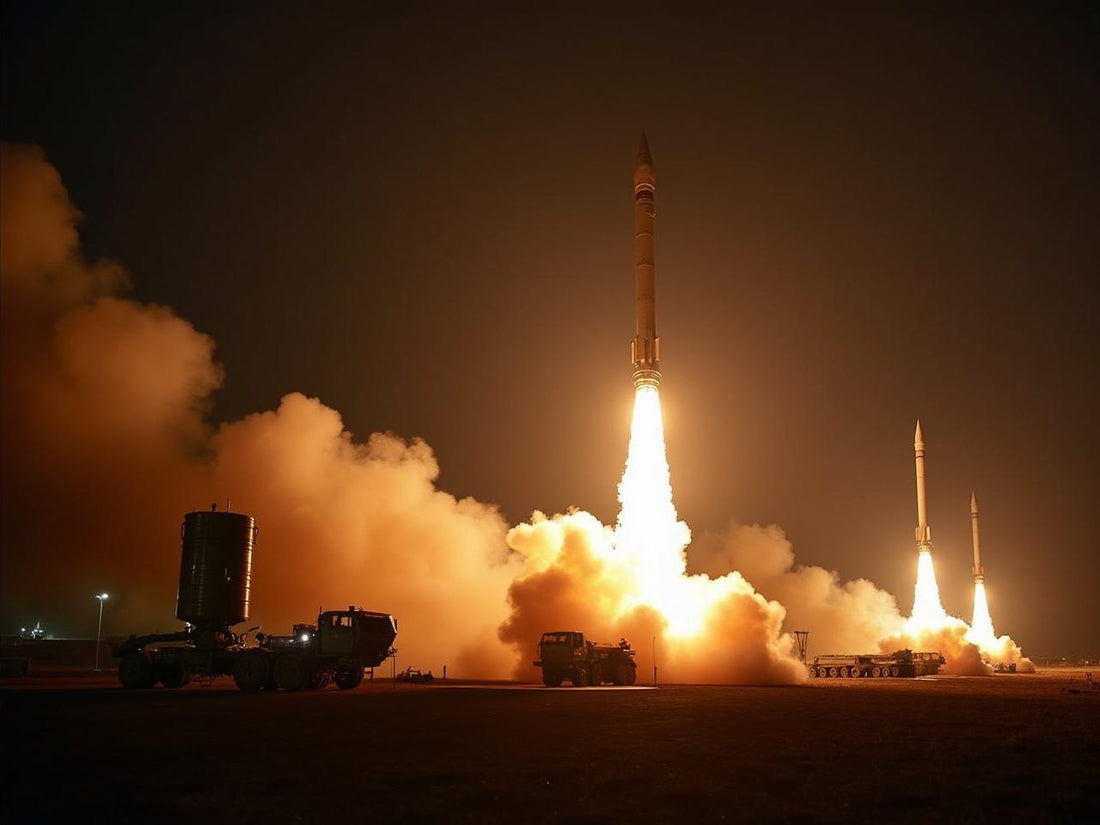Top 10 Intercontinental Ballistic Missiles in 2025

Intercontinental Ballistic Missiles (ICBMs) are a cornerstone of strategic deterrence, capable of delivering nuclear warheads across continents with ranges exceeding 5,500 kilometers. These missiles, along with submarine-launched ballistic missiles (SLBMs) of similar range, form the backbone of nuclear arsenals for several nations. In 2025, advancements in missile technology have enhanced their range, accuracy, payload capacity, and ability to evade defense systems.
This article explores the top 10 ICBMs and SLBMs with intercontinental range, based on their strategic impact, technological sophistication, and operational status. The list draws from recent analyses, acknowledging that rankings may vary due to differing criteria and limited public data on some systems.
Understanding ICBMs and Their Role
ICBMs are long-range missiles that follow a ballistic trajectory, exiting the atmosphere and re-entering to strike targets with high precision. They are primarily designed to carry nuclear warheads, often equipped with Multiple Independently Targetable Reentry Vehicles (MIRVs) that allow a single missile to hit multiple targets.
SLBMs, launched from submarines, share similar capabilities and are sometimes included in ICBM discussions due to their strategic role in nuclear triads (land, sea, and air-based systems).
These missiles are critical for deterrence, ensuring a nation can respond to or deter nuclear threats. As of 2025, Russia reportedly maintains the largest ICBM arsenal, with an estimated 306 strategic missiles capable of carrying up to 1,185 nuclear warheads, followed by the United States, China, India, and North Korea.
Top 10 ICBMs in 2025
The following list ranks the top 10 ICBMs and SLBMs based on their range, payload, technological advancements, and strategic significance. Note that the LGM-35 Sentinel is included in some sources but is not yet operational, so its placement is speculative. The Hwasong-17 from North Korea is also considered, though its reliability is debated.
| Rank | Missile Name | Country | Range (km) | Warhead Capacity | Deployment Type |
|---|---|---|---|---|---|
| 1 | RS-28 Sarmat | Russia | 10,000–18,000 | Up to 15 MIRVs or hypersonic glide vehicles | Silo-based |
| 2 | DF-41 | China | 12,000–15,000 | Up to 10 MIRVs | Road-mobile, rail-mobile, silo |
| 3 | Trident II D5 | USA/UK | Over 12,000 | Up to 8–12 MIRVs | Submarine-launched |
| 4 | RS-24 Yars | Russia | 10,500–12,000 | Up to 4 MIRVs | Mobile/silo-based |
| 5 | M51 | France | Up to 10,000 | MIRV capable | Submarine-launched |
| 6 | R-29RMU2.1 Layner | Russia | Over 11,000 | Up to 12 MIRVs | Submarine-launched |
| 7 | LGM-30G Minuteman III | USA | Over 13,000 | Single warhead (previously up to 3 MIRVs) | Silo-based |
| 8 | JL-2 | China | 8,000 | Single warhead or MIRVs | Submarine-launched |
| 9 | Agni-V | India | 5,000–8,000 | MIRV capable | Road-mobile |
| 10 | Hwasong-17 | North Korea | Up to 15,000 | 2,000–3,500 kg payload | Road-mobile |
1. RS-28 Sarmat (Russia)
The RS-28 Sarmat, nicknamed "Satan II," is Russia’s most advanced ICBM, designed to replace the Soviet-era R-36M2 Voevoda. This heavy, liquid-fueled missile has a range of up to 18,000 km, enabling global targeting from silo-based launch sites. It can carry a 10-ton payload, including up to 10 heavy or 15 lighter nuclear warheads, or three Avangard hypersonic glide vehicles.

The Sarmat employs Fractional Orbital Bombardment System (FOBS) technology, allowing it to attack over the South Pole to bypass northern missile defenses. Its advanced countermeasures enhance its ability to evade interception. The missile entered operational service in September 2023, though test failures in 2024 suggest ongoing refinement.
- Specifications: Length: 35.3 m, Diameter: 3.0 m, Launch Weight: 208,100 kg, Propulsion: Three-stage, liquid-fueled
- Status: Operational, with limited deployment due to test challenges
2. DF-41 (China)
The DF-41 is China’s most advanced ICBM, known for its versatility and survivability. This solid-fueled, road-mobile missile has a range of 12,000–15,000 km and can carry up to 10 MIRVs. Its deployment options include road-mobile, rail-mobile, and silo-based variants, making it difficult to target.

The DF-41 achieves speeds up to Mach 25, enhancing its ability to evade defenses. By 2025, at least 20 units are operational, with 120 new silos identified in Gansu province, indicating significant expansion of China’s nuclear arsenal.
- Specifications: Length: 20–22 m, Diameter: 2.25 m, Launch Weight: 80,000 kg, Accuracy: ~100m CEP
- Status: Operational, with multiple units deployed
3. Trident II D5 (United States/United Kingdom)
The Trident II D5 is a submarine-launched ballistic missile (SLBM) deployed on U.S. Ohio-class and U.K. Vanguard-class submarines. With a range exceeding 12,000 km, it is renowned for its accuracy and reliability.

The missile can carry up to 8–12 MIRVs, making it a cornerstone of both nations’ nuclear deterrents. Its submarine-based platform enhances survivability, as submarines are difficult to detect. The U.S. operates 14 Ohio-class submarines, each carrying up to 24 Trident II missiles, totaling 288 missiles with 1,152 MIRV warheads.
- Specifications: Range: Over 12,000 km, Warheads: Up to 8–12 MIRVs
- Status: Operational, widely deployed
4. RS-24 Yars (Russia)
The RS-24 Yars is a modern Russian ICBM, an upgraded version of the Topol-M, deployable from both silos and mobile launchers. It has a range of 10,500–12,000 km and can carry up to 4 MIRVs.

The Yars is equipped with advanced penetration aids to counter missile defense systems, enhancing its strategic value. Russia operates approximately 204 Yars missiles, making it a key component of its nuclear arsenal.
- Specifications: Range: 10,500–12,000 km, Warheads: Up to 4 MIRVs
-
Status: Operational, widely deployed
5. M51 (France)
The M51 is France’s primary SLBM, deployed on Le Triomphant-class submarines. With a range of up to 10,000 km, it is MIRV-capable and features advanced stealth and penetration technologies. The M51 has three variants (M51.1, M51.2, and M51.3, with the latter projected for 2025), ensuring France’s nuclear deterrence. Its submarine-based platform provides a robust second-strike capability.

- Specifications: Range: Up to 10,000 km, Warheads: MIRV capable
- Status: Operational, with M51.3 in development
6. R-29RMU2.1 Layner (Russia)
The R-29RMU2.1 Layner is a Russian SLBM deployed on Delta IV-class submarines. It has a range exceeding 11,000 km and can carry up to 12 MIRVs. An upgraded version of the R-29RMU Sineva, the Layner offers improved accuracy and penetration capabilities, making it a vital part of Russia’s sea-based nuclear deterrent.

- Specifications: Range: Over 11,000 km, Warheads: Up to 12 MIRVs
-
Status: Operational
7. LGM-30G Minuteman III (United States)
The LGM-30G Minuteman III is the United States’ only operational land-based ICBM, in service since the 1970s. It has a range exceeding 13,000 km and was originally MIRV-capable but is currently configured to carry a single warhead due to arms control agreements. The U.S. maintains 405 Minuteman III missiles across three bases, with plans to replace them with the LGM-35 Sentinel starting in 2029.

- Specifications: Range: Over 13,000 km, Warheads: Single warhead (previously up to 3 MIRVs)
- Status: Operational
8. JL-2 (China)
The JL-2 is China’s submarine-launched ballistic missile, deployed on Jin-class submarines. With a range of approximately 8,000 km, it can carry a single warhead or multiple MIRVs, forming a key part of China’s second-strike capability. The JL-2 is a land-based variant of the DF-31, adapted for submarine use.

- Specifications: Range: 8,000 km, Warheads: Single warhead or MIRVs
- Status: Operational
9. Agni-V (India)
The Agni-V is India’s intercontinental ballistic missile, operational since 2021. With a range of 5,000–8,000 km, it is road-mobile and MIRV-capable, allowing India to strike targets across Asia and into Europe. A successful MIRV test in March 2024 under Mission Divyastra marked a significant milestone in India’s strategic capabilities.

- Specifications: Range: 5,000–8,000 km, Warheads: MIRV capable
- Status: Operational
10. Hwasong-17 (North Korea)
The Hwasong-17 is North Korea’s most advanced ICBM, unveiled in 2020 with a range of up to 15,000 km, potentially capable of striking the continental United States. It has a payload capacity of 2,000–3,500 kg and is road-mobile. While tested multiple times (March 2022, November 2022, March 2023), its reliability remains uncertain, leading to debate about its inclusion in top rankings.

- Specifications: Range: Up to 15,000 km, Payload: 2,000–3,500 kg
- Status: Tested/Development
Additional Notes
- LGM-35 Sentinel (United States): Although included in some rankings, the Sentinel is under development in 2025, with deployment planned for 2029. It is expected to feature advanced security, cyber resilience, and a modular design, replacing the Minuteman III. Its inclusion in top lists is based on anticipated capabilities rather than current operational status.
- Other Missiles: Older systems like Russia’s RS-20V (SS-18 Satan) and RS-18 (SS-19 Stiletto) remain operational but are less advanced than newer missiles like the Yars and Sarmat. Israel’s Jericho III, with a range of 4,800–11,500 km, is also noted but not consistently ranked among the top due to limited public data.
- Global Context: Russia leads in ICBM numbers, followed by the U.S. and China. India and North Korea are emerging players, with India’s Agni-V and North Korea’s Hwasong-17 marking significant advancements. The inclusion of SLBMs like Trident II, M51, and JL-2 reflects their strategic equivalence to land-based ICBMs in nuclear triads.
Strategic Implications
These missiles underscore the ongoing global competition in strategic military technology. Their ability to deliver multiple warheads, evade defenses, and operate from mobile or submarine platforms enhances deterrence but also raises concerns about arms races and global stability.
The development of hypersonic glide vehicles and advanced countermeasures, as seen in the Sarmat and DF-41, highlights the evolving nature of missile technology. However, the reliability of newer systems like the Hwasong-17 and the deployment challenges of the Sarmat suggest that operational effectiveness varies.



















